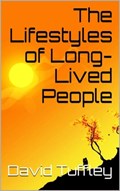It’s the thing that most people desire – a long-life, well-lived -- yet achieving it can be elusive. Sure, medical technology goes a long way, but what about staying healthy in the first place? This eBook is a summary of the collected wisdom of hundreds of researchers who have studied the ingredients of a healthy, long-lived lifestyle.
It should be good news to us all that there are relatively simple rules that we inherited from our evolutionary past that have been proven to be true for everyone, everywhere; a few simple rules that you can apply to your life, wherever you live.
Much research has been done into what makes people live a long time and be healthy. We now know that there are certain common factors that are true at a human level, true for everyone, everywhere. Of course, how these factors are put into practice is going to be different from place to place, but if we know what those underlying factors are, we can use our imaginations to work out how to live them ourselves.
Looking at it from an evolutionary point of view, these factors describe the ideal way for humans to live. This is the key to understanding a long and happy life.
The fossil record tells us that the human lineage split from our closest living relative, the chimpanzee, around five million years ago. By 200,000 years ago, humans were anatomically similar to people today. If a human from that time were brought into the modern world, cleaned up, given a haircut and dressed in regular clothes, it would be difficult to tell them apart from someone born in the modern era.
Darwin’s Theory of Evolution by Natural Selection tells us that the creatures that survive are those that are best suited to life in a particular environment. Humans evolved on the African savannah, so we are well-adapted to those conditions. Our ancestors lived in small family groups on the vast grassy plains along with all the other species, many of which still there today.
Humans were not at the top of the food-chain. That position was occupied by Lions and other big cat predators. Our ancestors foraged for whatever they could find. For millions of years early humans lived like this.
Then, about 120,000 years ago, our ancestors wandered north and found their way across the narrow seas to Eurasia. So began the human diaspora that resulted in humans spreading across that vast land-mass to the Americas and down to Australia.
Logic would suggest that the key to long life is to adapt your lifestyle so that it is similar to what has been called the Environment of Evolutionary Adaptedness. This is the set of what anthropologists might call the ‘recurring selection pressures’ that have shaped us into the creatures we are today.
A less scientific way of expressing this idea is to say that we should learn to live in harmony with Nature; to harmonize our inner world with the outer world.
The chapters that follow outline the essential features of the lifestyle of early humans. They serve as a model that you can use to adapt your lifestyle so that it is in harmony with our inner nature.
I do not suggest that we should leave our homes and become hunter-gatherers on the African savannah again. Let us make full use of the modern conveniences at our disposal, but let us do so in full knowledge of the grounding principles that make us human. If you can find a way to combine the two, you are well on your way to achieving a long and happy life.

